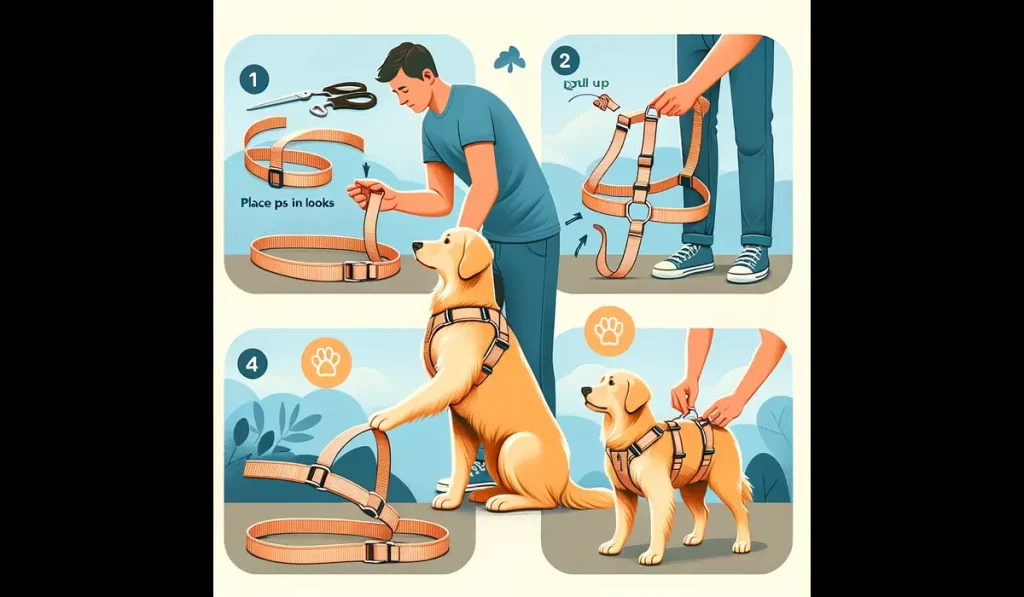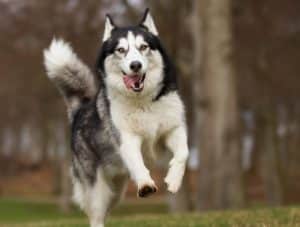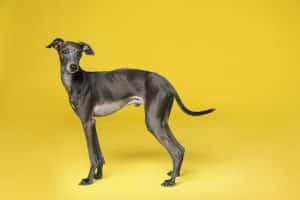How to Choose and Put on a Dog Harness
Choosing the right harness and putting it on your dog correctly ensures their comfort and safety on walks. Here’s a detailed guide:
Why Use a Harness?
- Pressure distribution: Harnesses distribute pressure across the dog’s chest and back, reducing strain on the neck compared to collars.
- Control: Some harnesses are designed to discourage pulling, making walks easier.
- Safety: Harnesses reduce the risk of a dog slipping free, especially for breeds prone to breathing difficulties.
Choosing the Right Harness
- Types:
- Back Clip Harness: Ideal for calm dogs who don’t pull.
- Front Clip Harness: Discourages pulling, good for training.
- Dual Clip Harness: Offers both front and back attachment for versatility.
- Step-In Harness: Easy to put on, good for dogs who dislike over-the-head harnesses.
- Safety Harness: Designed for car safety, attaches to seatbelts.
- Sizing: Measure your dog’s girth (widest part of the ribcage), neck, and possibly chest width. Harnesses should be snug but allow you to fit two fingers underneath.
How to Put on a Harness
- Calm your dog: Offer treats and praise to make it a positive experience.
- Spread out the harness: Identify the different loops and where they go on your dog’s body.
- Step in or over the head: Depending on the harness, have your dog step into the loops or guide it over their head.
- Secure the buckles: Buckle the harness and check the tightness.
- Adjust the straps: Ensure a snug fit with two-fingers-width space.
Specific Instructions for Back Clip and Front Clip Harnesses
- Back Clip:
- Larger loop goes over the head, smaller loop around the chest.
- Buckle the strap under the belly.
- D-ring should be on the dog’s back.
- Front Clip:
- D-ring is on the dog’s chest.
- Colored straps go over the head.
- Buckle the strap under the belly.
Key Takeaways
- A good harness improves walks for both you and your dog.
- Measure your dog carefully before choosing a harness.
- Start with short sessions to get your dog comfortable with the harness.
- Always adjust the harness for a secure and comfortable fit.
- Never jerk or pull harshly on the leash, even with a harness.
With patience and the right harness, your dog will be happily and safely walking with you in no time!
How to Put on a Dog Harness? Guides to Follow While Buying Your Dog’s Harness
While buying stuff for our pets, we all will go for the best one to provide them the utmost comfortability; here are the steps that you should go with while buying a dog harness.
- While buying a harness, the master should always take care of his dog’s behavior and temperature while having a walk. Some harnesses are designed so well that they are not used to pull the leash of the dogs, which comforts them throughout the walk.
- The owner should always measure the collar and neck of the pet as a perfect-sized harness can divide the pressure of the owner and the weight of the leash on some of their body parts like shoulders, chest, and back. The dividing of the pressure throughout the body makes the dog less tired and helps to enjoy much.
What are the Benefits of Having a Harness for Your Dog?
We have also seen that some dog owners use collars for their dogs. A collar is a good choice for those dogs who don’t run during an outing and stay calm.
But for those dogs who are playful and get excited over an unknown thing, using a collar can be dangerous because they can run away at any time, so using a harness instead of a collar is a better choice for the dogs who use it to pull their leash during outings.
Apart from this, there are many other benefits of using a harness which include the prevention of diseases like breathing issues which are often called dyspnea in some breeds like brachycephalic, french dogs, and bulldogs.
The most important benefit of using a harness is the distribution of the leash, which reduces the stress of the dog during the walk. It also provides a comfortable outing for the owners with big dogs by reducing the pulling force of the dog.
How to Take the Measurement of Your Dog for a Harness?
As the sizes provided by different companies in providing harnesses are different, therefore the master should take care of the measurement of the circumference at the widest part of the ribcage of the dog. The most important part of the measurement is the girth of the dog, as the size of the waist will decide which is the exact harness.
To take the measurement of your dog’s girth, you can simply take a measuring tape and round it through the waist of your dog, and note it down to find the circumference. The measurement should be an inch more because the harness should be a bit larger but not tighter, as a tighter harness can make your dog uncomfortable.
The measurement of the neck is also necessary for choosing a harness in some cases, so you can just follow the procedure of taking the measurement of the girth in this case.
Some harnesses might also require the width of the chest, which you can take by keeping the measuring tape at the mid-chest of the dog and over the breast bone.
What are the Best Harnesses to Choose for Your Dog?
As per the studies done on the harnesses available in the market, we have come up with some of the best harnesses for your dog.
Here is the ultimate guide to follow
Back Clip Harness
Back clip harnesses are specially designed for calm and composed ones who don’t use to pull on the leash or run while having a walk.
The metal D loop attached at the back of the harness where the leash of the dog is attached stops the dog from pulling.
In addition, the top handle of the back clip harness provides an easy grip for the owner to hold the dog in a time of need.
Front Clip Harness
The design of the front clip harness is similar to the back clip harness; the only difference is that the metal loop in the front clip harness is located a few inches away from the dog’s chest. This type of harness is helpful for the owners who are training their dogs to not pull their leash while walking.
Dual Clip Harness
Dual clips are designed to provide attachment to the dog’s body on both the front and the backside of the dog.
This type of harness was commonly used by dog owners to teach their dogs the correct manner of walking.
But it can be quite uncomfortable for the dog as the two loops can scratch the pet’s skin due to continuous rubbing against it.
Step In Harness
It can be one of the best choices for your dog, as many dogs hate those which were inserted in their head. The buckle and double D rings of this harness protect the dog from getting slipped.
Safety Harness
Safety harnesses are used in cars; these are attached to seat belts of the car to protect your dog from jerks on the road. Again, this is the best for those who keep their pet with them while traveling.
How to Correctly Orient the Straps of the Harness?
If a person is using a harness for the first time, then it is common to get confused, as the harness gets twisted sometimes while moving it from one place to another.
The easiest way of placing the straps correctly is by focusing on the D-shaped loop, as all the straps were directly attached to the ring according to their sides.
In addition, some of the straps will be designed to be on the chest, whereas some were to be on the back of the dog.
How to Put on a Harness?
Below are the steps on how to put on a harness:
- At first, you should show some love to your dog to convince him to the harness
- Place the detached harness on the ground and spread out the straps to make it easy for your dog to get into it.
- Now gently try to put your dog’s paws in the spread-out straps.
- Put the right one in the right loop and then the left one in the left loop.
- Now pull the harness up onto your dog to let him fit perfectly in the harness.
- Secure the clips as needed and according to the size of your dog’s neck.
- Now adjust the harness by rotating a little so that your dog doesn’t come out of it.
How to Put on a Back Clip Harness?
Guide to follow on how to put on a back clip harness:
- Spread the harness on the ground in an exact manner.
- The larger side of the harness with a buckle will get over the front legs, while a smaller side of the front loop will get tied to his head.
- Now bend the knees of your dog and bring the upper body forward and down and slip the first loop over the body.
- Now take the strap below the belly of your dog and clip it according to its size a slide away from the front legs.
- The D-shaped loop is required to be at the top of the back to provide an easy grip of the body to the owner.
- Now you can clip the leash to the ring by making a few adjustments.
How to Put on a Front Clip Harness?
The steps are mentioned below on how to put on a front clip harness:
- Then, take the harness and line it up on the ground.
- The D-shaped loop should be on the front side of the chest of the dog, whereas the buckle should be below the chest of the dog.
- Now slightly put your dog near the harness and try to put the colored straps over the head.
- After entering the colored straps in the head, try to clip the buckle up on the strap below the belly.
- Now check the tightness of the harness and adjust it accordingly.
The steps for putting on the best ones are similar to the above-mentioned harnesses.
How to Adjust the Harness Perfectly?
Adjusting the harness is probably the most important part that you should be aware of while putting the harness into your dog. If the harness will not get tied perfectly, then it can cause some scratches to the pet and can make him uncomfortable throughout the walk.
Proper use of the buckles for tightening the straps is necessary, as it also provides an easy grip to the owner by inserting their fingers into the ring.
Proper checking of the clips and buckles is necessary for avoiding any kind of issues on the outing. For example, the owner should check if the straps of the harness are rubbing against the skin of the dog, as it can cause scratches to the skin; it’s also necessary to check the buckles and straps to avoid slipping out of the dog in the way.








